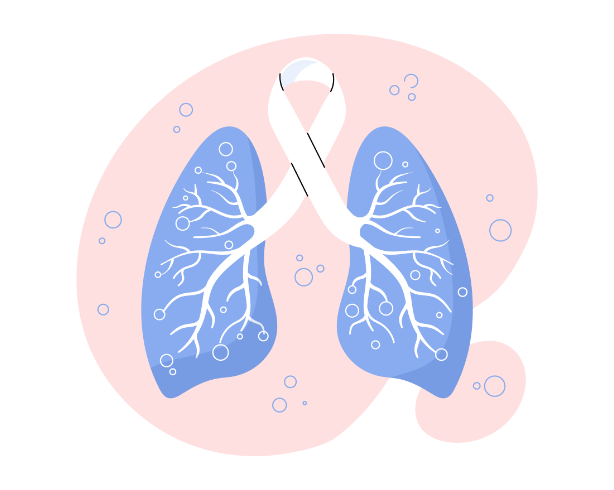Lung Cancer
Lung cancer is a complex disease characterised by the abnormal growth of cells within the lungs, often forming malignant tumours.
It stands as one of the foremost cancers diagnosed worldwide and represents around 9.1% of all new cancer diagnoses in Australia, making it the fourth most diagnosed cancer in Australia for both men and women. The condition manifests in various forms, each presenting unique challenges in diagnosis and treatment. Here we will explore these types of lung cancer, their causes, symptoms, how they are diagnosed, and how they are treated.

Types of Lung Cancer
Lung cancer is divided into two main types: non-small cell lung cancer (NSCLC) and small cell lung cancer (SCLC). NSCLC is the most common, with different subtypes like adenocarcinoma, squamous cell carcinoma, and large cell carcinoma. On the other hand, SCLC is less common but spreads quickly and is more aggressive.
Symptoms of Lung Cancer: Understanding the Signs
Recognising the symptoms of lung cancer is crucial for early detection and timely intervention. Here's a detailed exploration of both early and advanced-stage symptoms:
In the early stages of lung cancer, symptoms may be subtle and easily overlooked. However, paying attention to the following signs can lead to early diagnosis:
- Persistent Cough: A chronic cough that persists for more than a few weeks, especially if it worsens over time or produces blood-tinged sputum, should not be ignored.
- Chest Discomfort: Patients may experience chest pain or discomfort that is often described as a dull ache or pressure in the chest, shoulders, or back. This discomfort may worsen with deep breathing, coughing, or laughing.
- Haemoptysis: Haemoptysis, or coughing up blood, is a concerning symptom that requires immediate medical attention. While not always indicative of lung cancer, it should be evaluated promptly to rule out serious underlying conditions.
- Unexplained Weight Loss: Significant and unexplained weight loss, often accompanied by loss of appetite, fatigue, and weakness, can be a sign of advanced lung cancer. This unintentional weight loss may occur despite maintaining normal eating habits.
As lung cancer progresses to more advanced stages, symptoms become more pronounced and debilitating:
1. Dyspnoea: Shortness of breath, or dyspnoea, is a common symptom of advanced lung cancer. Patients may experience difficulty breathing, even at rest, due to tumour growth obstructing airways or causing fluid accumulation in the lungs.
2. Fatigue: Cancer-related fatigue is a pervasive symptom that significantly impacts quality of life. Patients may feel extreme tiredness or weakness that is not relieved by rest and interferes with daily activities.
3. Recurrent Infections: Lung cancer can weaken the immune system, making patients more susceptible to infections such as pneumonia or bronchitis. Recurrent respiratory infections may signal advanced disease and should be promptly evaluated by a healthcare provider.
4. Cachexia: Severe weight loss and muscle wasting, known as cachexia, are hallmark features of advanced cancer. Cachexia can lead to profound weakness, fatigue, and a decline in overall physical function.
If you are experiencing any of these symptoms and are seeking medical evaluation to determine the underlying cause and receive appropriate care, contact North Brisbane Sleep and Thoracic to book an appointment today. We are conveniently located in both North Lakes and Clayfield!
Causes of Lung Cancer: What You Need to Know
Understanding the various factors that contribute to the development of lung cancer is crucial for prevention and early detection. Here's a closer look at the main causes:
Smoking cigarettes is the leading cause of lung cancer. Cigarette smoke contains more than 7,000 chemicals, including at least 70 known to cause cancer. These harmful substances damage the cells lining the lungs, leading to genetic mutations that can result in cancerous growths. The longer a person smokes and the more cigarettes they consume, the greater their risk of developing lung cancer. Quitting smoking significantly reduces this risk over time, highlighting the importance of tobacco cessation programs and support.
Even if you don't smoke yourself, being exposed to second-hand smoke from others' cigarettes can increase your risk of lung cancer. Second-hand smoke contains many of the same harmful chemicals as direct cigarette smoke, putting non-smokers at risk, especially in enclosed or poorly ventilated spaces.
Radon gas, a natural by-product of the radioactive decay of uranium in soil, rock, and water, poses a significant threat to respiratory health and is a recognised cause of lung cancer. Unlike other indoor pollutants, radon is invisible, odourless, and tasteless, making it difficult to detect without specialised testing. This characteristic, combined with its widespread presence in the environment, underscores the importance of regular testing for radon levels in homes, workplaces, and other indoor environments.
Once inhaled, radon undergoes radioactive decay, emitting alpha particles that can damage the cells lining the lungs. This cellular damage disrupts normal cell function and DNA integrity, potentially leading to the development of cancerous tumours over time. Prolonged exposure to elevated radon levels increases the risk of lung cancer, with the cumulative effect being particularly concerning. Moreover, radon exposure synergises with cigarette smoking to further elevate lung cancer risk, highlighting the importance of mitigating exposure for both smokers and non-smokers alike. Implementing mitigation measures, such as sealing cracks in foundations, improving ventilation, and installing radon mitigation systems, is crucial for reducing radon-related lung cancer risk. By raising awareness, promoting testing, and enforcing mitigation measures, authorities can help mitigate the impact of radon exposure on public health and promote healthier indoor environments for all.
Certain occupations involve exposure to carcinogenic substances and hazardous materials that can increase the risk of lung cancer. Industries such as mining, construction, manufacturing, and transportation expose workers to asbestos, silica dust, diesel exhaust, and other harmful agents known to cause lung cancer. Implementing strict workplace safety measures, providing proper protective equipment, and minimising exposure to carcinogens is vital for protecting workers' health and reducing occupational lung cancer risk.
While environmental exposures play a significant role in lung cancer development, genetic factors also contribute to an individual's susceptibility to the disease. Some people inherit genetic mutations that predispose them to lung cancer, particularly in genes related to DNA repair and cell growth regulation. Understanding one's family history of cancer and genetic predispositions can help identify individuals at higher risk and inform personalised screening and prevention strategies.
By addressing these various causes of lung cancer through public health initiatives, tobacco control efforts, workplace safety regulations, and genetic screening programs, we can work towards reducing the burden of this disease and improving outcomes for individuals at risk. Individuals need to be aware of these risk factors and take proactive steps to minimise their exposure, leading to a healthier future with fewer cases of lung cancer.

Diagnosing Lung Cancer
When it comes to diagnosing lung cancer, a series of comprehensive tests and procedures are employed to confirm the presence of malignancy, determine its extent, and inform treatment decisions. From initial screenings to advanced molecular testing, each step in the diagnostic process plays a crucial role in guiding healthcare professionals towards effective management strategies.
The journey towards a lung cancer diagnosis typically begins with a series of initial tests aimed at investigating abnormal symptoms and assessing overall health status:
- Chest X-ray: This painless imaging scan provides an initial glimpse into the lungs, capable of detecting tumours as small as one centimetre in diameter.
- CT scan: Utilising X-ray beams, CT scans offer detailed images of the lungs, facilitating the identification and characterisation of suspicious lesions.
- Lung Function Test (Spirometry): This test evaluates lung capacity and efficiency, providing valuable insights into respiratory function.
Learn more about Spirometry here. - Blood Tests: Comprehensive blood analysis assesses various parameters, including cell counts, organ function, and overall health markers.
Biopsy samples undergo molecular testing to identify genetic mutations and protein markers, guiding personalised treatment approaches:
• Genetic Changes: Assessment of genetic mutations such as EGFR, ALK, and ROS1 informs targeted therapy options.
• Proteins: Evaluation of proteins like PD-L1 helps predict responsiveness to immunotherapy.
Upon detection of a suspicious lesion, further diagnostic investigations are warranted to confirm the presence of lung cancer. Biopsy remains the gold standard for definitive diagnosis:
- CT-Guided Lung Biopsy: Under local anaesthesia, a needle is guided by CT imaging to obtain a tissue sample from the lung lesion.
- Bronchoscopy: A flexible tube with a camera is inserted through the nose or mouth into the airways to collect tissue samples.
- Endobronchial Ultrasound (EBUS): This specialised bronchoscopy technique allows for visualisation and sampling of deeper lung tissues and nearby lymph nodes.
- Mediastinoscopy: Invasive but occasionally necessary, this procedure involves sampling lymph nodes in the mediastinum via a small incision in the neck.
- Thoracoscopy: Utilising a camera-equipped tube, tissue samples are obtained through minimally invasive video-assisted thoracoscopic surgery (VATS).
- Biopsy of Neck Lymph Nodes: Cells may be sampled from neck lymph nodes using ultrasound-guided needle aspiration.
Following confirmation of lung cancer, additional tests are conducted to determine the disease stage and extent of spread:
- PET-CT scan: Combining PET and CT imaging, this comprehensive scan provides detailed information on tumour activity and metastasis.
- CT or MRI of the Brain: Imaging of the brain aids in detecting metastatic lesions.
- Abdominal CT or Bone Scan: These tests evaluate for distant metastases in other organs or bones.
National Lung Cancer Screening (From 1 July 2025)
The Australian Government’s National Lung Cancer Screening Program offers eligible Australians a low-dose CT scan to detect early-stage lung cancer. As a trusted respiratory group in Brisbane, NBST is your referral partner for managing patients through screening and follow-up care at both our Clayfield and North Lakes locations.

Staging Lung Cancer
Staging lung cancer is essential for determining the extent of the disease and guiding treatment decisions. There are different staging systems used for non-small cell lung cancer (NSCLC) and small cell lung cancer (SCLC), reflecting the distinct characteristics of each type of cancer:
The TNM system categorises NSCLC based on three key factors: tumour size, lymph node involvement, and metastasis.
- Tumour Size: This parameter evaluates the size of the primary tumour and its extent of invasion into surrounding tissues. Tumour size is classified into several categories, ranging from small, localised tumours to larger tumours with extensive invasion.
- Lymph Node Involvement: Lymph node involvement indicates whether cancer has spread to nearby lymph nodes. The presence and extent of lymph node metastasis are assessed through imaging studies and sometimes confirmed through biopsy.
- Metastasis: Metastasis refers to the spread of cancer beyond the lungs to distant organs or tissues. Evaluation for metastasis typically involves imaging tests such as PET-CT scans to detect any signs of cancer spread.
- Using the TNM system, lung cancer is staged from stage I (early-stage disease) to stage IV (advanced-stage disease), with each stage representing different combinations of tumour size, lymph node involvement, and metastasis. This staging system helps oncologists determine the most appropriate treatment approach for each patient, ranging from surgery for early-stage disease to systemic therapy for advanced-stage disease.
SCLC is staged using a simpler two-stage system due to its aggressive nature and tendency for rapid spread.
- Limited Stage: In this stage, cancer is confined to one side of the chest and may involve nearby lymph nodes. While the cancer is still considered localised, it has the potential to spread beyond the initial site.
- Extensive Stage: Cancer has spread widely within the lung, to the other lung, or to distant organs outside the chest cavity. This stage typically indicates advanced disease with a poorer prognosis.
The two-stage system for SCLC reflects the rapid and extensive spread of this type of cancer, guiding treatment decisions towards aggressive systemic therapies such as chemotherapy and radiation.
Understanding the stage of lung cancer is crucial for developing personalised treatment plans and providing patients with accurate prognostic information. By accurately staging the disease, healthcare providers can optimise treatment strategies to improve outcomes and quality of life for individuals diagnosed with lung cancer.
Various factors, including disease stage, treatment response, and overall health influence prognosis in lung cancer:
Factors Considered in Prognosis:
- Test results and cancer characteristics.
- Type and stage of lung cancer.
- Tumour growth rate and treatment response.
- Patient demographics, fitness, and health status.
- Smoking history and cessation efforts.
While confronting the prognosis can be daunting, advancements in treatment, including targeted therapy and immunotherapy, offer hope for improved outcomes, even in advanced stages of the disease.
Navigating the complexities of lung cancer diagnosis requires a multidisciplinary approach, tailored to individual patient needs and informed by the latest advancements in medical science. Through diligent screening, precise diagnostics, and personalised treatment strategies, healthcare professionals strive to optimise patient outcomes and foster a brighter future in the fight against lung cancer.
Treatment Options for Lung Cancer
When it comes to treating lung cancer, several options are available, each serving a unique purpose in fighting the disease. Let's break them down into simpler terms:
Each of these treatments has its own benefits and risks, and the best approach depends on factors like the type and stage of cancer, overall health, and personal preferences. Working closely with a healthcare team can help determine the most suitable treatment plan for each individual with lung cancer.
What it does: Surgeons remove the cancerous tumour from the lung. This can involve taking out a small part of the lung (segmentectomy), a whole lobe (lobectomy), or even the entire lung (pneumonectomy).
Why it's used: Surgery aims to get rid of the cancer completely. It's often the first choice for cancer that hasn't spread beyond the lung and can offer a chance for a cure.
What it does: Chemotherapy uses powerful drugs to kill cancer cells. These drugs can be given through a vein or taken as pills.
Why it's used: Chemotherapy is often used to shrink tumours before surgery, kill any remaining cancer cells after surgery, or treat cancer that has spread beyond the lung. It can also help relieve symptoms and improve quality of life.
What it does: Immunotherapy drugs help the body's immune system fight cancer by blocking proteins that prevent immune cells from attacking cancer cells.
Why it's used: Immunotherapy can be effective in treating advanced lung cancer that hasn't responded to other treatments. It can sometimes lead to long-lasting remissions and improved recovery rates.
What it does: Radiation therapy uses high-energy rays to kill cancer cells. It can be focused precisely on the tumour, sparing healthy tissues.
Why it's used: Radiation therapy can be used either to cure the cancer or to relieve symptoms like pain or difficulty breathing. It's sometimes used alongside surgery or chemotherapy to make the treatment more effective.
What it does: Targeted therapy drugs target specific genetic changes in cancer cells, such as EGFR, ALK, or ROS1 mutations.
Why it's used: These drugs work differently from chemotherapy and can be more effective with fewer side effects in certain cases. They're used when cancer has specific genetic changes that make it susceptible to these treatments.
Prevention and Risk Reduction
Preventing lung cancer and reducing the risk of developing it involves taking proactive steps to minimise exposure to known risk factors. Let's explore these strategies in simpler terms:
If you smoke, quitting is the single most effective way to reduce your risk of lung cancer. Quitting smoking involves getting support through counselling, using medications that help reduce cravings, and engaging in community programs aimed at helping people quit.
Radon is a harmful gas that can seep into homes from the ground. Testing your home for radon levels and taking steps to mitigate its presence, such as installing ventilation systems, can lower your risk of exposure and reduce the likelihood of developing lung cancer.
Certain jobs expose workers to substances known to cause cancer, like asbestos or silica. Occupational safety measures, such as identifying hazards, implementing engineering controls, and providing protective gear, help protect workers from these carcinogens and reduce the risk of work-related lung cancer.
Detecting lung cancer early can significantly improve treatment outcomes. Screening programs, using low-dose CT scans, target high-risk individuals to catch cancer at its earliest stages when it's most treatable. These programs use risk assessment tools to identify those who could benefit most from screening.
By adopting these preventive measures and risk reduction strategies, individuals can take proactive steps to lower their chances of developing lung cancer and improve their overall health and well-being.

Take Charge of Your Health with North Brisbane Sleep and Thoracic.
If you're experiencing symptoms, it's time to take action. Our expert team is here to provide compassionate care and accurate diagnosis at our convenient North Lakes and Clayfield locations. Don't let uncertainty hold you back – schedule your appointment here today and let's navigate this path to wellness together. Your health matters, and we're here to support you every step of the way.
Contact us to book an appointment
Visit us at either our Clayfield or North Lakes locations and experience compassionate care in a comfortable environment, tailored to meet your unique needs.

